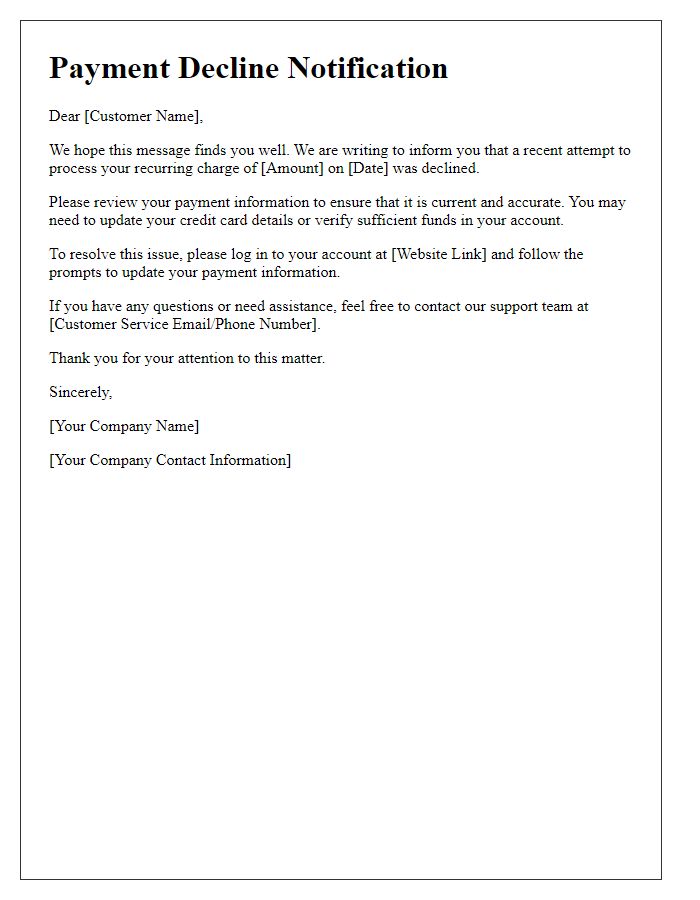Hey there! We all know that managing payments can sometimes get a little messy, and that's why we're here to help. If you've run into issues with your recurring payments not going through, don't worry; you're not alone! Let's dive into the reasons why this might happen and explore how you can fix it, so you never miss another payment. Keep reading to uncover some helpful tips and solutions!

Personalized Greetings and Identification
Recurring payment failures can often lead to inconvenience for users subscribed to services such as streaming platforms, subscription boxes, or software applications. A personalized greeting helps establish a connection, addressing the user by name (e.g., "Dear John Doe"). Identification of the specific service or product involved (e.g., "Your subscription to XYZ Streaming Service") clarifies the context. Notifications may include details about the failed payment attempt, referencing payment methods like credit cards or bank accounts, and potential reasons for the failure (e.g., insufficient funds, card expiration). Emphasizing urgency regarding reactivation of the service can encourage prompt resolution, reminding users of their subscription benefits, such as exclusive content or discounts.
Clear Reference to Payment Details
Recurring payment failures often happen due to insufficient funds or expired payment methods. For instance, a transaction scheduled for the first of every month may fail if the credit card linked to the subscription has expired or the account does not have enough balance to cover the monthly fee of $29.99. Notifications sent to users typically include reference details such as the payment method's last four digits, transaction IDs like 123456789, and the next scheduled payment date for clarity. These details help users quickly identify issues related to their billing information, whether it's an outdated debit card from Bank of America or an invalid PayPal account.
Specific Error or Problem Description
Recurring payment failures can significantly disrupt the billing process of subscription services. Common issues include insufficient funds, expired credit cards, or network errors during transaction processing. For instance, a transaction might fail if the card's expiration date is past due (often just a month or two after the expiration), leading to disrupted access to premium features. Furthermore, merchants may face complications if recurring charge attempts (usually scheduled monthly or annually) exceed a certain limit due to continuous errors, resulting in potential loss of customer engagement and revenue. Addressing these failures promptly through customer notifications or alternative payment methods enhances retention and satisfaction.
Resolution Steps and Contact Information
Recurring payment failures frequently disrupt subscription services, causing inconvenience for both users and providers. Customers may encounter issues due to insufficient funds, expired payment methods, or technical errors in processing systems. In resolving these failures, users are typically advised to check their bank account balance to confirm available funds, update credit card information (noting expiration dates), and ensure their bank is accepting transactions from the service provider. Additionally, contacting customer support may provide further assistance; users should be prepared to provide account details and error messages. Most subscription services offer multiple contact options, including support emails, chat services, or dedicated helplines, ensuring timely resolution of payment-related concerns.
Reassurance and Accountability Statement
Recurring payment failures can cause inconvenience for both service providers and customers, particularly in subscription-based services like streaming platforms or software tools. Regular failures, often due to expired payment methods or insufficient funds, can disrupt service continuity and lead to account restrictions. It is crucial for companies to implement transparent communication, notifying users of payment issues promptly, and providing clear instructions for resolving them. Maintaining confidence in the billing process and ensuring users understand their account status fosters trust and encourages timely payment updates. Robust account management systems can help mitigate such issues, ensuring seamless transactions and enhancing customer satisfaction overall.













Comments